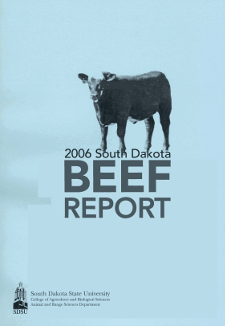Document Type
Report
Report Number
2006-14
Publication Date
2006
Keywords
cow/calf, research unit, teaching, interseeding legumes, pastures, spring, crossbreeding system
Summary
The SDSU Cow Calf Teaching & Research Unit (CCU) provides cattle and facilities for numerous Animal Science and Range Science classes and a variety of research projects. The CCU also provides cattle for the SDSU Little International, Block & Bridle activities, numerous judging team workouts, and other activities that bring potential students to the SDSU campus. Kevin VanderWal and Anna Drew, along with part time student employees, manage the herd and assist with beef cattle activities throughout the year. Faculty members that have conducted or contributed to research in recent years include: Dick Pruitt, George Perry, Sandy Smart, Jeff Clapper, Bill Epperson, and Vance Owens. Recent studies have included: fenceline weaning, control of estrus and ovulation, supplementation of cows during the breeding season, extending the grazing season with small grain pasture and interseeding legumes in grass pastures. About 150 Angus and SimAngus females are bred each spring, and 110 calve starting in late February. Although it is not feasible to maintain all the breeds that are important to this region, two breeds provide variation for teaching purposes and still allow us to use the herd for research where limiting variation is important. The goal of our breeding program is to produce bulls that fit into one of the following categories: 1. Calving ease Angus bulls to breed to heifers and cows. 2. High growth Angus bulls (purebred and high percentage) to breed to cows. 3. SimAngus hybrid bulls for a simple crossbreeding system. Proven sires are used by artificial insemination. The average expected progeny differences for the herd and AI sires used in 2006 are shown in Tables 1 and 2. The EPDs reflect selection for a balance of above average weaning weight, yearling weight, scrotal circumference, and milk EPDs along with below average birth weight. More recently we have placed emphasis on increasing marbling and rib eye area as long as other important production traits are not sacrificed. In recent years, breed associations in the US have developed economic indexes to simplify selection. EPDs are weighted by their economic value to rank animals on the net profit per head of their progeny compared to the progeny of other animals raised in the same environment. To use the indexes effectively a person would need to know: 1) What traits are included in the index? 2) What production and marketing scenario is the basis of the index?
Number of Pages
3
Format
application/pdf
Language
en
Publisher
South Dakota State University
Rights
Copyright © 2006 South Dakota State University
Recommended Citation
Pruitt, Dick, "SDSU Cow/Calf Teaching and Research Unit" (2006). South Dakota Beef Report, 2006. 15.
https://openprairie.sdstate.edu/sd_beefreport_2006/15


